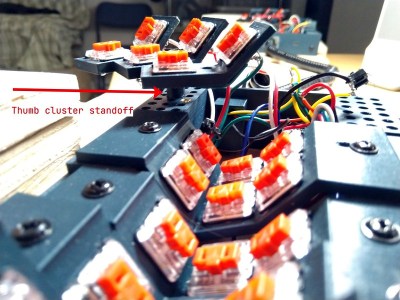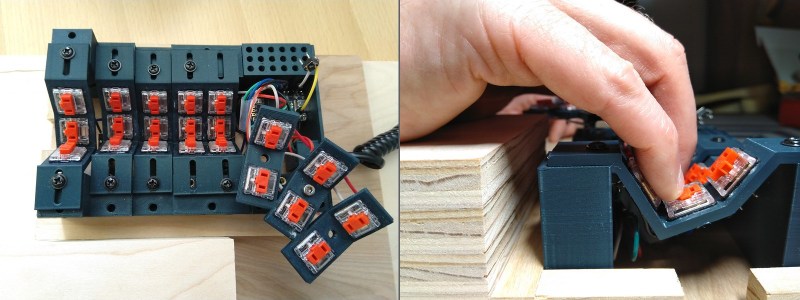Just when we thought we’d seen the peak of ergonomic, split keyboards, along comes [Peter Lyons] with the Squeezebox — an adjustable, column-staggered, streamlined beauty with 21 keys per hand. Much like the Kinesis Advantage and the Dactyl, the user’s fingers are allowed to dangle comfortably and stay in their naturally curled position, moving as little as possible between keys, rows, and columns. But the Squeezebox goes a few steps farther to reduce finger travel.
 For starters, each column of keys is adjustable on the fly in the Y-direction by loosening the screw and sliding it until it’s just right. The columns are also adjustable in the Z-direction, but for now, this requires reprinting a few parts. In case you didn’t notice, the grid is pretty tightly packed, and those low-profile Kailh choc switches are naked to the world, mostly because keycaps wouldn’t fit anyway.
For starters, each column of keys is adjustable on the fly in the Y-direction by loosening the screw and sliding it until it’s just right. The columns are also adjustable in the Z-direction, but for now, this requires reprinting a few parts. In case you didn’t notice, the grid is pretty tightly packed, and those low-profile Kailh choc switches are naked to the world, mostly because keycaps wouldn’t fit anyway.
At that angle, there’s no reaching required at all between the middle and bottom rows. The 100° corner that they form both invites and supports chording — that’s pressing multiple keys simultaneously to do some action. There’s no real need to reach for the top row, either, because [Peter] merely moves his finger upward in the Z-direction a little bit to hit those. The similarly-angled thumb clusters are chord-able as well, and their position relative to the mainland is adjustable thanks to a grid of holes that are meant for threaded inserts. Genius!
For the next version, [Peter] plans to bring the three sets of thumb cluster switches closer together, and arrange them like a tri-fold science fair display board. Be sure to check out the super cool but somewhat impossible-to-solder prototypes in the build log, and stay for more stuff in the huge build gallery. Typing demo is after the break.
Still too much travel for your taste? How about a 5-way for each finger?
Thanks for the tip, [Tyberius Prime]!















What all these ideas miss is a mouse pointer you don’t have to move for, which is the one thing I miss about not using a laptop (preferably with the IBM Thinkpad style joystick) much anymore. With such a hand form keyboard layout if you make it light enough the whole thing could perhaps be the head of a joystick, or even just a normal optical mouse. Or just take a key out off the thumbs for a joystick.
Not that you need a mouse perhaps, but good as a terminal and Vim/Emacs is there are other things like web browsing that really doesn’t suit a keyboard alone..
Don’t get me wrong though, neat and compact project keyboard. Seems like a simpler and more durable build than many similar ergonomics. So it gets a teacup salute from me, though why I am awake past midnight with a cuppa is beyond me….
You can do that pretty easily with qmk.
On my dactyl manuform, I have a layer with a “+” layout pad under my right hand to move the cursor, with left click in the middle of the direction keys, middle click above the “cursor right” key, and right click on the key to the right of the “cursor right” key.
It works well.
But I’ve also seen some variants that implement either a trackball or a trackpoint.
I’d love to see this, maybe with two of the thumb keys replaced with a single thumbstick for mousery…
“things like web browsing”: Qutebrowser. https://qutebrowser.org/
(Although the irony is that in writing this reply, I’m reminded that the “Post Comment” button here somehow evades Qutebrowser’s link-detection scheme, so I did have to touch the mouse after all. JavaScript something-something.)
I use qutebrowser as well. Interestingly, my “Post Comment” button works by tabbing and selecting with the spacebar.
Latest qutebrowser (live ebuild) on Gentoo, if that helps.
With Eye tracking of course!
Super comfortable formaldehyde and plywood wrist support? Neat idea if those were addressed but not exactly brand new either.
When can we just literally only think about typing something and have it come up at a reliable, accurate and very quick rate instead of spending at best a few seconds to look at a single word using maybe eye tracking inputs? Understanding that this is still in research stages but it feels a bit like fusion technology and it always being a decade out. Looking at you, ITER Tokamak.
Will gaming tournaments transition into people just staring at the screen while still playing a then popular game? Winners getting paid millions of dollars? Can people “talk” (now just communicate) with each other virtually and in real time without having to type on a touch screen or try to talk to it and have it be sort of right but also wrong a fairly often amount of time as well?
My guess is mouse will be (or is already) be replaced by touchscreen.
And keyboard, our plain old keyboards wont evolve: they will disappear for Brain Computer Interface so no need to try changing it for a bulkier non standard version made of wood, next tech is out of reach of tinkerers.
Let’s face it, keyboard typing is hard and is a skill: Millennials grew up with tech and only few manage typing on a keyboard but Generation Z simply don’t: I’m amazed to see a youngster thumb-typing on a smartphone but cannot manage much on a computer, this interface will disappear.
Elevators and escalators still didn’t replace the stairs. An I expect a teleportation device wouldn’t replace the stairs either. But that’s just a wild guess.
But what I do think to know is that the easiest (or cheapest) solution is in many ways the solution that survives the longest. No matter how high-tech you go there will always be a need for the most basic functions most likely because they are reliable in some way, so I expect keyboards to stay with us for a long time although their shape may change.
Regarding the project, interesting approach, looking forward to v2.0
I would be happy for the mouse to be replaced by a flat touchpad, maybe like those on laptops but the size of a sheet of paper? (This comment posted with a trackball…)
But you can’t always be reaching up to touch the screen, for human ergonomic reasons that aren’t ever going to go away. Shoulder strain is what killed the light pen. And you can’t have the screen too low for too long, because of neck strain.
Humans are built to look ahead, but work at waist level. That’s cool, when you don’t have to look at what you’re doing for 8 hours per day…
Thouchpads are useless for anything more than stabbing an icon amd you know you can have more than one screen (think wagon setups)
I will just take a normal mouse… Can hit any pixel on the screen with less movement than dialing a phone
These sorts of things will always stay niche because they require way too much optimization and are way too inflexible for the miniscule advantage they offer.
How much faster can you actually be than a “normal” ergonomic keyboard? How much more “ergonomic” is this actually when your arm and hand position is so optimized that you basically have to stay in that one single position the entire time? Is that even more ergonomic if you’ve optimized in a way that you just sit completely unmoving for 8 hours? What if it’s actually slightly healthier when you have to move your arms around between mouse and keyboard from time to time?
Maybe it’s better to optimize for health rather than speed? Just a thought…
>naturally curled positon.
Oh come on hackaday. Everybody knows that the curled hand position is un-natural and a result of not stretching enough through either work or stretches.